#cultural weapons
Note
hi! im nehiyawak (otherwise known as cree), specifically from the plains region, and i'd like to know if our culture has any references in atla/tlok or if we inspired anything! love the blog btw, as a native in the process de-colonization it actually helps me in a way my brain is more inclined to process knowledge ❤️
Thank you for the kind words! It's always nice to hear that this blog has inspired a love for learning in someone. <3
As for aspects of Nehiyawak (Cree) culture in ATLA, what immediately comes to mind are some of Sokka's weapons:


Both ball-headed war clubs and gunstock war clubs were utilized by Nehiyawak (Cree) tribes. Ball-headed war clubs were commonly used by tribes that lived near the Great Lakes region, such as Moose Cree people. Gunstock war clubs were used by tribes that live in North America's Great Plains region, such as Plains Cree people. Sokka's club and boomerang are modeled after these weapons.
The bone chokers that both Kuruk and Arnook wear are also associated with Great Plains tribes:

Like what I’m doing? Tips always appreciated, never expected. ^_^
https://ko-fi.com/atlaculture
358 notes
·
View notes
Text
I will take this a step farther, i want some good ass cultural weapons too. Please....i beg you anet...
5 notes
·
View notes
Text
”Your comfort is not more valuable than another person’s life, let alone hundreds or thousands of other people’s lives” is a very simple and obvious ethical concept and yet USAmericans will regularly stand up and argue the opposite with their whole chests. Peak imperialism brainworms
#this goes for engineers who take cushy jobs at raytheon & poor teens who join the military & union bosses at weapons manufacturing plants#who claim that their only responsibility is to secure good jobs for american workers. if you wouldn’t become a hitman for cash#then don’t help kill people for a paycheck#imperialism#no more war#cultures of dissociation#my posts
427 notes
·
View notes
Text
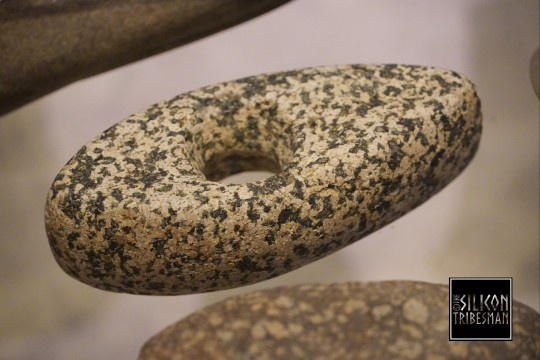






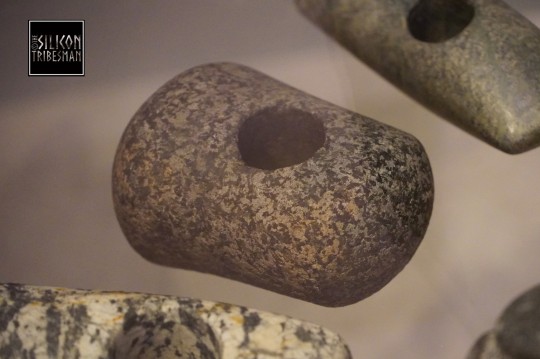

Prehistoric Axehead and Macehead Selection, The National Museum of Scotland, Edinburgh
#ice age#stone age#bronze age#copper age#iron age#axe#axehead#macehead#hammer axe#prehistoric weapons#prehistoric tools#archaeology#relic#ancient living#ancient craft#ancient cultures#stonework#stonecarving#prehistoric#prehistory
262 notes
·
View notes
Text
Arms and Armor of the Hallstatt Celts: A (not-so) Brief Overview
The Hallstatt culture is an archaeologically-defined material culture group. The typesite for this group is in Hallstatt, Austria, where a deep salt mine which had been in use since the Neolithic served as the lifeblood of the local community. A substantial cemetery of approximately 1,300 burials near the mine has helped to clearly define artistic trends associated with this cultural group. The culture is associated with early Celtic or proto-Celtic language speaking groups, and for a long time, was thought to have been the origin of the proto-celtic language. This idea has since been debunked, as it is now known the first proto-Celtic speakers predated the Hallstatt culture.
The Hallstatt culture is divided into four phases, A-D (henceforth abbreviated as Ha. A-D). The first two of these phases are associated with the end of the bronze age in the region, the last two, with the beginning of the iron age.

Since the defining of the culture in 1846, Hallstatt influence has been found from Eastern France to Hungary, as far south as Serbia and as far North as Poland. The core Hallstatt region covers much of Austria and Southern Germany. By the Ha. C period, distinct practices had arisen in the Hallstatt sphere of influence: distinct enough for academics to split the culture into two “zones”, the East and the West.

Unfortunately, due to the antiquity of this culture and the utter lack of any written records concerning them, the archaeological record is both relatively thin, and the only source of information available for these people. As such, in constructing a timeline of Hallstatt arms and armor, there will be substantial gaps which we can only hope will be filled by future discoveries.
Armor
Three types of armor are commonly found in Hallstatt contexts: belts, cuirasses, and helmets.
That broad belts (both of leather and of bronze) are considered armor in the ancient Mediterranean is clear from references in which these items are placed in context with other armor. In the Iliad, for example, in book 7 after Ajax and Hector meet on the field of battle and fight to a stalemate, they exchange equipment. Hector “gave over his silver-studded sword, bringing with it the sheath and well-cut baldric” (l. 303-304), while Ajax reciprocated with “his war-belt bright with crimson” (l. 305). Additionally, a short list of military equipment issued by the Neo-Assyrian empire recovered in Tel Halaf lists 10 leather belts alongside bows, swords, spears, and other arms and armor.
A number of bronze and gold belt plates survive from both the Eastern and Western zones, though most of these plates date to the Ha. D period.
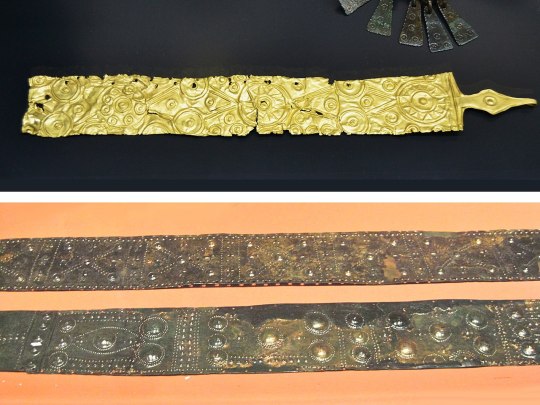
While the majority of these plates are decorated with embossed and incised geometric patterns, some (particularly from the Eastern zone) include scenes of warriors on foot and on horseback.
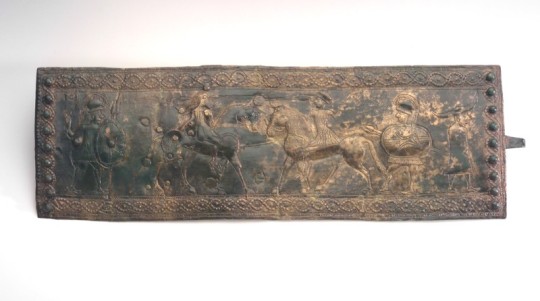
The cuirasses of the Hallstatt period exhibit an interesting progression. In their most basic form, these bronze cuirasses remain essentially the same from Ha. A-D. They are characterized by essentially simple forms: a tubular breast and backplate which terminates at the waist and includes a tall standing collar to defend the neck. The earliest examples, however, include substantial embossed decoration in much the same manner as appears on the belt plates.

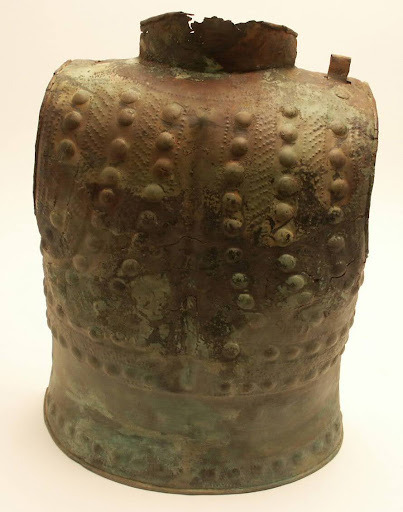
Only in the late Ha. B to early Ha. C period does this decoration begin to take on a more anatomical form; a group of seven cuirasses recovered in Marmesse, France in 1974 shows this evolution nicely. These cuirasses retain the same form, though a slight taper is now evident near the waist. The circular embossing closely resembles that of the previous period, however embossed lines are now apparent, and the placement of the embossing is such as to evoke the musculature of the warrior wearing it.
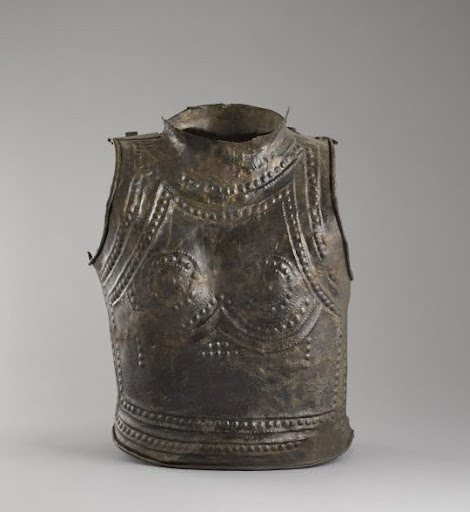

The final stage of the cuirasse’s evolution arrives in Ha. D. This form is much more plain, lacking the apparent horror vacui which typified earlier iterations of this style. Instead, the anatomical element is even more pronounced: embossing emphasizes the warrior’s pectoral and abdominal muscles, and additional circular bronze plates are riveted to the upper chest to simulate nipples.
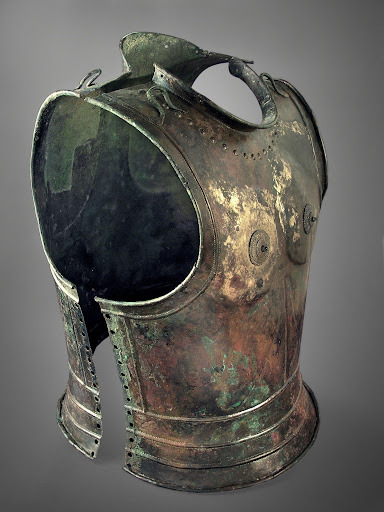
The final element of armor with substantial enough evidence in a Hallstatt context to be addressed is the helmet. Unfortunately, surviving helmets are extremely scarce, and there is no pictorial evidence to consult prior to the Ha. D period.
Four helmet types appear both archaeologically and artistically in Hallstatt contexts. We will call these the crested, the plated, the double-crested, and the Negau.
Only one artistic example of the crested helmet is to be found, and no archaeological examples. It is to be found on a grave good in the shape of a wagon adorned with many figures made ca. 600 BC and recovered in Strettweg, Austria.
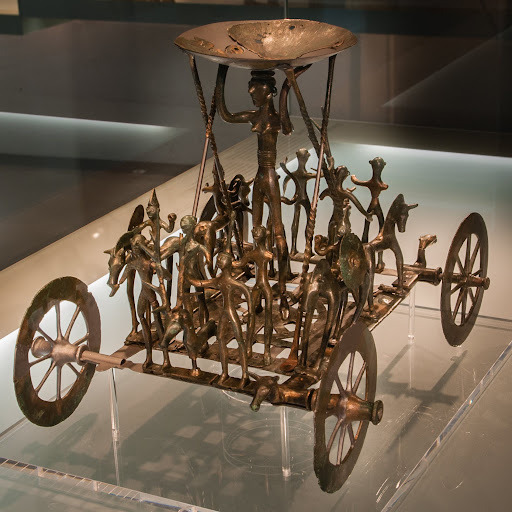
A find from Normandy (outside the Hallstatt sphere of influence) dated ca. 1200-700 BC shows what this type of helmet may have looked like.
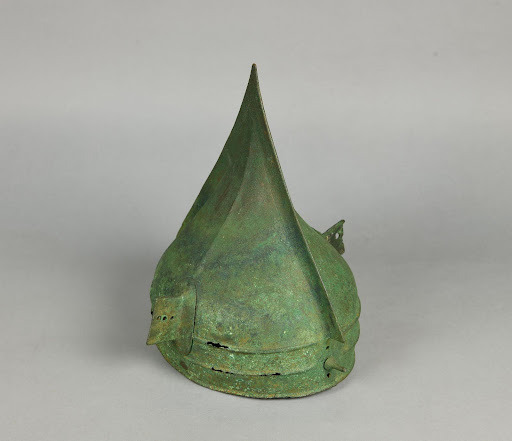
The plated type is nearly as obscure, represented by only a single survival and a single artwork. The helmet, recovered in Šentvid, Slovenia and dated ca. 800-450 BC, is curious for the distinct pearly texture of its surface.
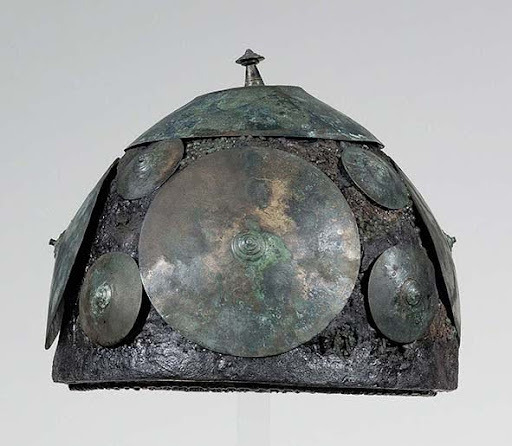
A number of similar helmets appear on a situla recovered from the Certosa Necropolis in modern Bologna, Italy. This situla is dated ca. 600 BC, and bears a striking resemblance to other situlae found in Hallstatt contexts.
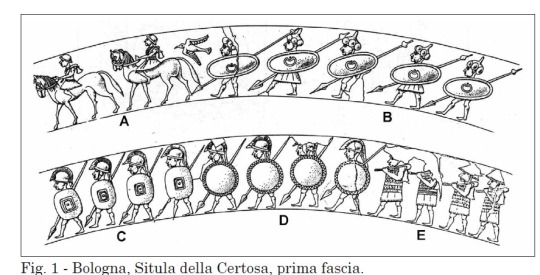
The most well attested form of Hallstatt helmet is the double-crested type. This type appears with the onset of Ha. D, and sees use until the end of the Hallstatt period. It is attested to by several survivals


and numerous depictions on a number of situlae
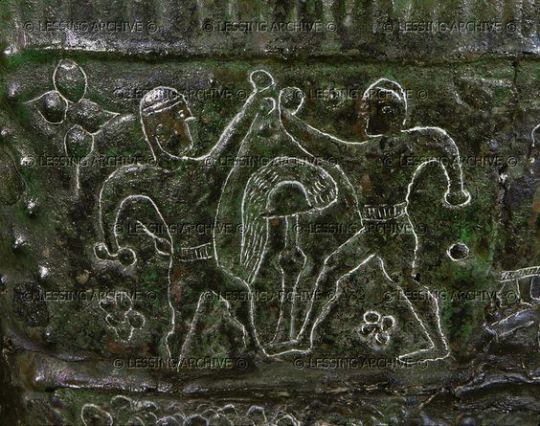
and belt plates.
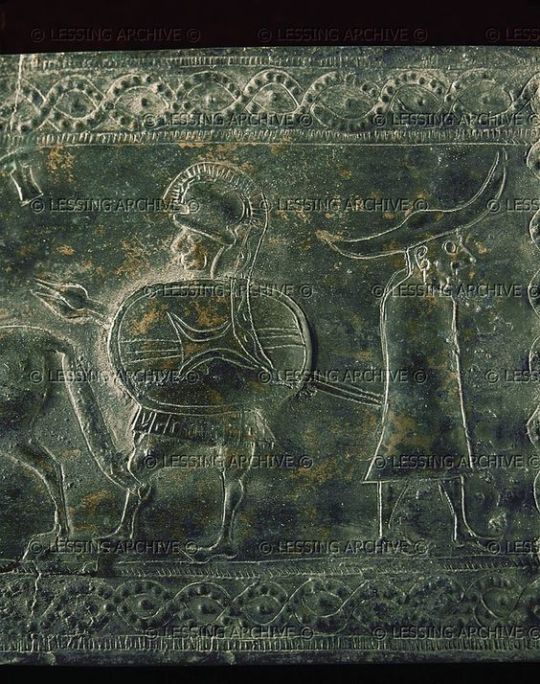
This type is so-called for the twin crests that adorn the helmet’s skull; crests which, as is attested by the pictorial evidence, served as anchors to large plumes likely made from horse hair.
The final type is named for a town in Slovenia where a large cache of helmets of this type was found in 1812. The Negau type appears at the very tail end of Ha. D, and primarily in Etruscan and Italic contexts. However a number of finds (including the eponymous horde) come from regions of Hallstatt (and eventually La Téne) influence.
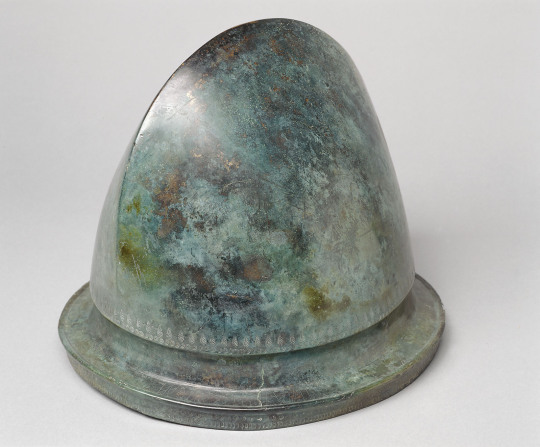
Weapons
The weapons which can be found in Hallstatt contexts are very much the same as those found elsewhere in Europe, consisting primarily on spears, axes, swords, and daggers. The spears and axes of the period are very similar to those found elsewhere in Europe and across the Mediterranean in the late bronze to early iron age, and as such will not be discussed further.

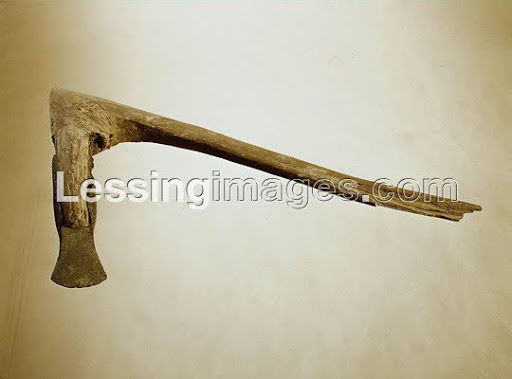
Indeed, even the swords of the Hallstatt bronze age (Ha. A-B) bear no significant differences from other swords found in Central and Western Europe at the time.
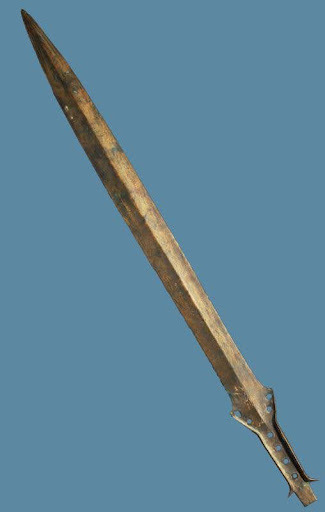
It is not until Ha. C, and the advent of the iron age, when two new types unique to the culture emerge. Though similar, these sword types, called Gündlingen
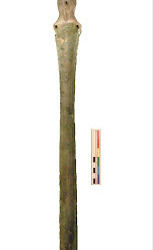
and Mindelheim, are distinguished by a number of factors.

First and foremost is size, with Mindelheim swords averaging around 85 cm or 33.5 in in length, while the Gündlingen type only averages 70-75 cm (27.5-29.5 in). Another striking feature of the Mindelheim type which is almost non-existent on Gündlingen swords is a pair of deep grooves on either side of the blade. Additionally, Gündlingen swords are only ever found in bronze, while Mindelheim can be found in either bronze or iron. Gündlingen swords seem to have been tremendously greater in popularity, with only 27 examples of the Mindelheim type being known to over 240 of the Gündlingen. There is also a geographical element: the majority of Mindelheim swords have been found in the east from Austria to Germany, Poland, and as far north as Sweden. Gündlingen swords, by contrast, have mostly been found in the west, as far as Britain and Ireland. Neither type, however, can be found in the core Hallstatt Regions after the advent of Ha. D, when daggers become the primary funerary good of the elite.
Daggers, of course, were not unknown in Hallstatt regions prior to 620 BC. A number of survivals from Ha. A-B attest to the fact that single-edged daggers were popular.

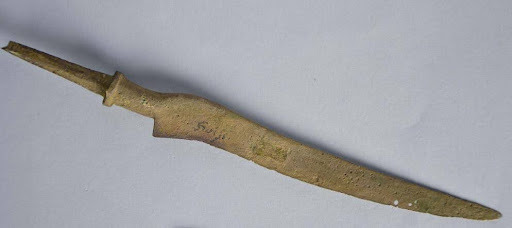
With the advent of the iron age and the rise in popularity of the peculiar Hallstatt sword types, daggers become more rare, until once again they spring back to the fore in Ha. D. At this time, a particular dagger type is almost ubiquitous. This dagger has long, straight quillons mirrored by a tubular pommel. The grip is thin, and the blade is broad and double-edged. This same basic form is present, both plain and with various embellishments, until the end of the Hallstatt period.

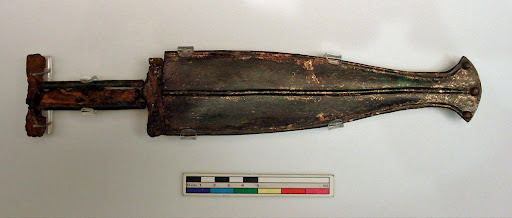
#arms and armor#weapons#armor#ancient history#hallstatt culture#celts#iron age#art#history#ancient celts#sword#axe#dagger#spear
135 notes
·
View notes
Text

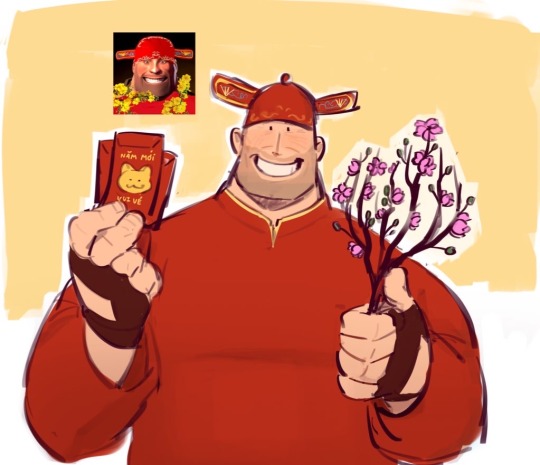
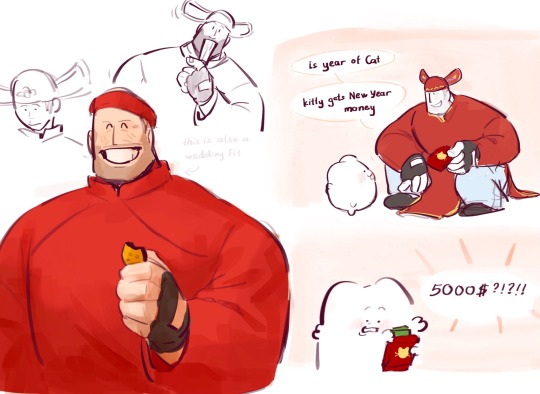
saw a cute viet edit of Heavy and i couldn’t help myself to draw him in áo dài!
i think people should draw their favorite characters in their cultures more actually!
#i dont get the chance to share my viet culture much so this made me so happy while drawing it#its also the cat year in vietnam#happy lunar new year#miss pauling#pauling tf2#heavy tf2#heavy weapons guy#tf2#team fortress 2#myart#artists on tumblr
2K notes
·
View notes
Text
🗣️ Pay very close attention!

Please forget, for a moment, that many people live in the intersection of simultaneously being Black + LGBTQ + refugee + Asian. Instead, I am asking you to look at how the Republican culture wars are pitting one identity against the other.
DeSantis has banned any mention of Gay and Trans people, Black Lives Matter, George Floyd, Critical Race Theory, and much more… but now he is mandating Asian American history.
Florida and other Republican controlled legislators around the country are whitewashing and erasing Black history from school history textbooks, while also making Asian history a requirement. ⁉️
Please be just a little bit curious.
You must ask yourself, why?
WHY would an abjectly racist politician ban one culture’s history, but require another’s?


DeSantis is playing Asian people, the “model minority,” against—in his eyes—all of the “less desirable” minorities: Black people, Lgbtq+ people, etc. etc. etc. It’s a classic divide and conquer strategy.
Please see his ploy for what it is. We are all stronger together. Republicans know this. It’s why they’re working so hard to drive wedges between us.
Don’t fall for the okie doke.
#politics#stop aapi hate#republicans#ron desantis#model minority#divide and conquer#martin niemoller#identity politics#weaponized identity politics#culture wars#idpol#education#intersectional feminism#intersectional social justice#intersectional womanism#feminism#womanism
758 notes
·
View notes
Text
I'm really not a villain enjoyer. I love anti-heroes and anti-villains. But I can't see fictional evil separate from real evil. As in not that enjoying dark fiction means you condone it, but that all fiction holds up some kind of mirror to the world as it is. Killing innocent people doesn't make you an iconic lesbian girlboss it just makes you part of the mundane and stultifying black rot of the universe.
"But characters struggling with honour and goodness and the egoism of being good are so boring." Cool well some of us actually struggle with that stuff on the daily because being a good person is complicated and harder than being an edgelord.
Sure you can use fiction to explore the darkness of human nature and learn empathy, but the world doesn't actually suffer from a deficit of empathy for powerful and privileged people who do heinous stuff. You could literally kill a thousand babies in broad daylight and they'll find a way to blame your childhood trauma for it as long as you're white, cisgender, abled and attractive, and you'll be their poor little meow meow by the end of the week. Don't act like you're advocating for Quasimodo when you're just making Elon Musk hot, smart and gay.
#this is one of the reasons why#although i would kill antis in real life if i could#i also don't trust anyone who identifies as 'pro-ship'#it's just an excuse to shut down legitimate ethical questions and engaging in honest self-reflective media consumption and critique#art doesn't exist in a vacuum#it's a flat impossibility for it not to inform nor be informed by real world politics and attitudes#because that's what it means to be created by human hands#we can't even make machine learning thats not just human bias fed into an algorithm#if the way we interact with art truly didn't influence anything then there would be no value in it#just because antis have weaponized those points in the most bad faith ways possible#doesn't mean you can ignore them in good faith#anyway fandom stans villains because society loves to defend and protect abusers#it's not because you get the chance to be free and empathetic and indulge in your darkness and what not#it's just people's normal levels of attachment to shitty people with an added layer of justification for it#this blog is for boring do-gooder enjoyers only#lol#knee of huss#fandom wank#media critique#pop culture#fandom discourse
205 notes
·
View notes
Text
It's difficult to me to put this into a coherent thought, but why are m*n so weird about women's naked pictures? The entire culture around pictures of women without clothes would not exist in a society without m*n. I literally can't imagine wanting to see a private picture of a woman that she doesn't want me to see. And if I accidentally glimpsed one I would not continue staring at it and I would try to see if it can get deleted because obviously that's private and shouldn't be out there, it's violating her privacy.
But they somehow built it into a whole thing where people having women's naked pictures is shameful,,, for the woman? They humiliate, HER, for violating her privacy? It's shameful that she, what, has a human body which is now recorded to be humiliated? How is any of that even related to her? All of us have human bodies, there's literally nothing we can do about it. I'm starting to question it because I can't imagine being so weird about a stranger woman's picture!
In a world that is normal to me, even if there were women's naked pictures, it wouldn't be anything relevant to anyone's interests, we already know what women look like and a woman who is a stranger obviously doesn't want anything to do with you so why would these pictures be interesting or anything to gawk at? Doesn't it just feel uncomfortable to know you're potentially looking at someone's body that they don't feel comfortable being seen? And even if they are comfortable, where is the appeal for looking at someone who didn't choose you to see that?
I know m*n just enjoy humiliating and violating women and you can get women to feel embarrassed and hurt by violating their privacy, but I can't grasp the concept of building an entire culture shaming women for being hurt and violated, it's like building a torture chamber that exploits someone's humanity.
In a society without m*n, women would be able to walk and swim around naked if they pleased, and nobody would stare, gawk, record or do anything to make them feel less than. They would still be regarded as a normal human being, going on about their business, enjoying life and the sun, absolutely deserving of respect and nobody would even want to put them in an uncomfortable situation where they feel hyper-aware of their bodies.
The mere premise of making women hyper-aware of what they look like is evil. Why does it matter? Why are m*n being weird about it? They could get hurt and embarrassed too if we suddenly started to violate their privacy just to humiliate every inch of their bodies! But we don't do that! Because there's nothing appealing about doing a disgusting shitty thing like that! Why do they find it appealing? Why do they push women to suicide over it? Why are they still allowed to be called a part of society after doing that? It doesn't make any sense.
#radical feminism#anti male#feminism#male violence#male predators#shaming women for having bodies#critical of male culture of finding nude pictures humiliating and using them as a weapon#womens naked pictures being shamed as if its a shameful thing for them to exist#but not a shameful thing to violate another persons privacy like that#radfems
204 notes
·
View notes
Text
Trying to kick my art block by doing the opposite of an easy drawing

#click to enlarge ofc#guess the century! lol.#i try to give them a big mix of styles from different cultures and decades because i feel like they would pick clothes/armour up and#hang on to them for as long as they can. it's also definitely not accurate but i do my best#this was going to be a tiny comic too. i should sleep instead lmao#siggy draws#all the clothes and the weapons.... why do i do this to myself#.......but it's fun and i love it#fighting the self-hate demon by posting this#things i'm going to fix: nicolo's quiver which is not in fact filled with crossbow bolts oops#also the length of those arrows...#yusuf's shoe that's falling off#and many more things
135 notes
·
View notes
Text
It will never stop amazing me (in a morbid fascination way) that every once in a while the shambling corpse of the ofmd fandom makes some noise and it's always - always - more warriors of the same faux-purity culture ship war that drove the whole fandom to eat itself alive and implode over the course of a single hiatus. How are they still doing this? They hate this character and any ship involving him so much they have made tags uninhabitable, harassed out every "problematic" fan they could and basically killed the fandom in the process, and now apparently a few of them are experimenting with active homophobia against his queer actor for being a "bad" queer (liking the character he played). They're running a toxic thoughtcrime surveillance state on an abandoned ghost town. And still innovating new ways to be more toxic about it!
It's absolutely bonkers 🙃
#the vast majority of sane people i recognize have long since cut their losses and moved on to blog about other interests#but damn if the hate bloggers can't keep going with only their own feedback loops once their targets dip#anyway i'll say it again - fascinating case study in a fandom destroying itself via weaponized social justice and anti culture#it should be autopsied once the radioactive elements finally decay away#ofmd harassment#ladyluscinia#(maybe i should look again at fic statistics. i know re: totals there have been less added post s2 than in deep hiatus)#(despite post s2 time technically being a longer window AND containing october and november while my 'deep hiatus' doesn't)#our flag means death
74 notes
·
View notes
Text
Building Up: Arctic Tools & Weapons Pt. 1
Wanted to do a post on real life arctic tools and weapons that I’d love to see the Water Tribe using. This will be a three-part series.
Ulu Knives

Probably the most well-known of Inuit tools due to their unique shape. It’s an all-purpose knife traditionally used by Inuit, Iñupiat, Yupik, and Aleut women. It’s utilized in applications as diverse as skinning and cleaning animals, cutting a child's hair, and slicing food. It could also be used as a punch knife. Traditionally, it was made with a handle of caribou antler, muskox horn or walrus ivory with a slate cutting surface. Nowadays, the blade is commonly made of steel. I think it’d be cool if Katara always carried one on her for emergencies and Sokka occasionally borrowed it to touch up his undercut.
Cable-Backed Bows

Also called Pisiksi in North Slope Iñupiaq. A cable-backed bow is a bow reinforced with twisted cables; the cables strengthen the bow and increase its power. These bows were utilized by both Inuit and Inupiat hunters; they used sinew cables on bows of baleen, horn, or antler to make them less likely to break from tension and give them greater spring. I love the distinct look of Copper Inuit bows (pictured above), as they’re like the diametric opposite of traditional Korean bows in shape.
Kakivak Spears

Kakivaks are three-pronged fishing spears with backward-facing barbs. Specifically, the outer prongs have their own “teeth” which point toward the center prong. The teeth are meant to hold the fish on to the main prong to stop it from falling off or wiggling away. These spears are primarily used by Canadian Inuit. It would probably really hurt to get stabbed in the arm or leg by one of these.
Like what I’m doing? Tips always appreciated, never expected. ^_^
https://ko-fi.com/atlaculture
488 notes
·
View notes
Text

Great point, Mrs. Betty Bowers. Unfortunately, logic seems to elude Second Amendment fanatics.🔫🤦🏻♀️
Mrs. Betty Bowers@BettyBowers
When was the last time you heard a Republican say, "Fentanyl doesn't kill, people who take it do"?|
Or "Anthrax doesn't kill, people who mail it do"?
#BanAssaultWeaponsNow
592 notes
·
View notes
Text
Long Pole Kung Fu
147 notes
·
View notes
Text






Bronze Shield Hoard, Yetholm, 1200 to 800 BCE, The National Museum of Scotland, Edinburgh
#ice age#stone age#bronze age#copper age#iron age#neolithic#mesolithic#calcholithic#paleolithic#prehistoric#prehistory#archaeology#metalwork#metalworking#shield#weapons#ancient living#ancient craft#ancient cultures#ancient design#relic#Scotland#Edinburgh
321 notes
·
View notes
Text
"as a jew"
*looks at blog*
"I passed by a synagogue once and my great great granddad's dog might have been jewish? so yea I'm like. the most jewish jew that ever jewed totally take whatever I say on jewish culture and history as gospel."
#an exaggeration yea#but i've said it before i'll say it a million time: most token jews are not in touch with judaism or jewish culture#they simply happened to be born jewish and never gave a shit about it until now#when they can use their jewishness as a weapon against the rest of the jewish community and be praised by the goyim#not that they aren't jewish. i'm not the type of person to call jews “not real jews”#(unless it's jvp because a lot of them ACTUALLY aren't really jewish)#but man do they grind my gears#ok lukas that's enough posts about antisemitism for today. it's 3:40 am i should go to sleep.#leftist antisemitism#antisemitism#jumblr#hila has spoken
54 notes
·
View notes